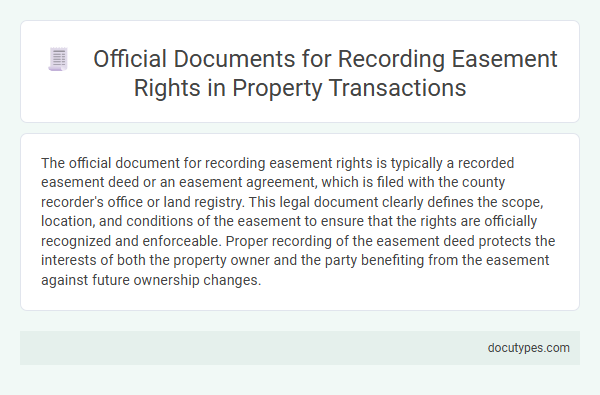The official document for recording easement rights is typically a recorded easement deed or an easement agreement, which is filed with the county recorder's office or land registry. This legal document clearly defines the scope, location, and conditions of the easement to ensure that the rights are officially recognized and enforceable. Proper recording of the easement deed protects the interests of both the property owner and the party benefiting from the easement against future ownership changes.
Introduction to Easement Rights in Property Transactions
Easement rights are legal permissions allowing one party limited use of another's property for a specific purpose. Understanding the official document for recording these rights is crucial in property transactions to protect Your interests.
- Easement Agreement - This is a written contract that details the terms under which easement rights are granted or reserved.
- Deed of Easement - The primary official document recorded in public land records to formalize and legally recognize easement rights.
- Title Report - A document that reflects existing easements and any restrictions affecting the property, essential for due diligence in transactions.
Importance of Official Documentation for Easements
The official document for recording easement rights is typically a recorded easement agreement or deed, which is filed with the local land records office or county recorder. This documentation legally establishes the specific rights and obligations associated with the easement, ensuring clarity and preventing disputes between property owners. Securing Your easement rights through official records provides long-term protection and supports clear property title transfers.
Types of Easement Rights Recognized Legally
The official document for recording easement rights is typically a recorded easement agreement or deed recorded with the local county recorder's office. This document legally establishes the specific rights and obligations related to the easement between the property owner and the easement holder.
Types of easement rights recognized legally include easement appurtenant, which benefits an adjacent property, and easement in gross, which benefits an individual or entity without regard to land ownership. Your property may also be subject to prescriptive easements, which are established through continuous and open use over time as recognized by law.
Common Official Documents Used for Easement Recording
The official document for recording easement rights is essential for legally establishing and protecting access privileges over another party's property. These documents vary by jurisdiction but commonly include specific forms that detail the nature and terms of the easement.
- Easement Agreement - A formal contract between property owners that outlines the scope and conditions of the easement rights.
- Deed of Easement - An official record filed with the county recorder's office that describes the easement and ensures it is legally binding.
- Plat or Survey Map - A detailed map submitted to clarify the exact location and boundaries of the easement on the property.
Recording these documents with the appropriate local government office legally protects the easement rights for current and future property owners.
The Role of Deeds in Documenting Easement Rights
What is the official document for recording easement rights? The deed serves as the primary legal instrument for documenting easement rights. It provides a clear, enforceable record of these rights tied to the property.
How do deeds play a role in documenting easement rights? Deeds explicitly describe the nature, scope, and terms of an easement, ensuring both parties understand their rights and obligations. Recording the deed with local government offices protects the easement against future disputes.
Easement Agreements: Key Provisions and Formats
| Topic | Description |
|---|---|
| Official Document for Recording Easement Rights | Easement agreements serve as the official legal documents that record easement rights on a property. These agreements establish the terms under which an easement is granted, ensuring that rights are recognized and enforceable by law. |
| Key Provisions in Easement Agreements |
|
| Formats of Easement Agreements |
|
Registering Easement Rights with Land Authorities
The official document for recording easement rights is typically known as an Easement Agreement or Easement Deed. Registering easement rights with land authorities ensures that the easement is legally recognized and attached to the property title. You must submit the signed easement document to the local land registry office for registration to protect your rights.
Legal Requirements for Validating Easement Documents
The official document for recording easement rights is typically a recorded easement agreement or deed. This document must be filed with the local county recorder or land registry office to establish the easement legally.
Legal requirements for validating easement documents include a clear description of the easement location, the parties involved, and the purpose of the easement. Your easement document must be signed, notarized, and comply with state and local laws to be considered valid.
Implications of Inadequate Easement Documentation
The official document for recording easement rights is typically a recorded easement agreement or deed, filed with the local county recorder or land registry office. This document legally establishes the scope and duration of the easement, ensuring clear property rights.
Inadequate easement documentation can lead to significant legal disputes between property owners and easement holders. Without precise records, easement boundaries and usage rights may be misunderstood or challenged, causing costly conflicts. Proper documentation protects property values and prevents future litigation by clearly defining access and usage privileges.
What Is the Official Document for Recording Easement Rights? Infographic

